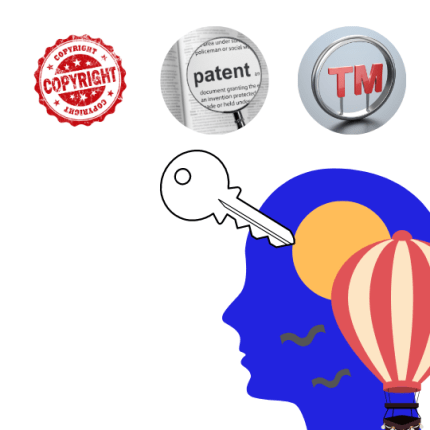
Trademarks, Copyrights, and Patents
Intellectual property (IP) includes trademarks, copyrights, patents, and trade secrets. It can be difficult to comprehend exactly what each sort of IP covers. However, recognising the distinctions between copyrights, trademarks, patents, and trade secrets will assist you in determining how to best protect your works and enforce your rights. A brief overview of these many forms of intellectual property, including a discussion of how they differ from copyright, is offered below.
Intellectual Property Rights
The legal safeguards known as intellectual property rights serve to protect intangible assets like inventions, creative works, brand identities, and trade secrets. The exclusive control that these rights—which include patents, trademarks, and copyrights—grant to creators and innovators promotes innovation, supports economic growth, and safeguards cultural development. IPRs are essential in fostering an active and competitive global environment by offering incentives for the creation and dissemination of ideas.
WHAT IS A TRADEMARK?
A trademark is a term, phrase, symbol, or design that identifies and differentiates the origin of one party’s goods from those of another. A service mark is a term, phrase, symbol, or design that identifies and distinguishes the provider of a service rather than a product. Examples include brand names, slogans, and logos.
WHAT IS A COPYRIGHT?
A copyright is a set of individual rights that you automatically acquire when you create an original work that is fixed in a tangible medium, such as an image, a book, or an mp3 file and many more. These rights include the ability to duplicate the work, create derivative works, distribute copies, perform the work publicly, and exhibit it publicly.
As the copyright owner, you have the ability to transfer an individual right or multiple rights to one or more people, as well as collectively transfer them to one or more people. This can be performed through licencing, assignment, and other types of transfer. Being a copyright owner also gives you control over whether and how your work is made available to the public.
WHAT IS A PATENT?
Patents safeguard inventions. These inventions can include new and beneficial processes, equipment, factories, material compositions, and enhancements to existing ones. The basic purpose of patent law is to promote innovation and the commercialization of technological discoveries. Patent law encourages innovators to openly disclose their inventions in exchange for specific exclusive rights.
IN A SUMMARY
| PARTICULARS | PATENT | TRADEMARK | COPYRIGHT |
| Governing Act | Indian Patent Act, 1970 | Trade Marks Act, 1999 | Copyright Act, 1957 |
| What’s protected? | Inventions include methods, machinery, manufacturing, and material compositions, as well as improvements to these. | Any term, phrase, symbol, or design that identifies and differentiates the origin of one party’s goods from those of another. | Original works of authorship include books, essays, music, photography, sculptures, dance, sound recordings, motion films, and others. |
| Requirements to be protected | An invention must be novel, helpful, and non-obvious. | A mark must be distinctive. | A work must be unique, innovative, and preserved in a concrete medium. |
| Term of Protection | 20 years | Trademark registered in India is valid for 10 years from the date of filing of an application. However, the trademark can be further renewed. | Author’s life plus 60 more years. |
| Rights Granted | Right to prevent others from manufacturing, selling, using, or importing the patented innovation. | The right to use the mark and prevent others from using identical marks in a way that could lead to confusion about the origin of the products or services. | The right to govern the reproduction, creation of derivative works, distribution, public performance, and display of copyrighted works. |


